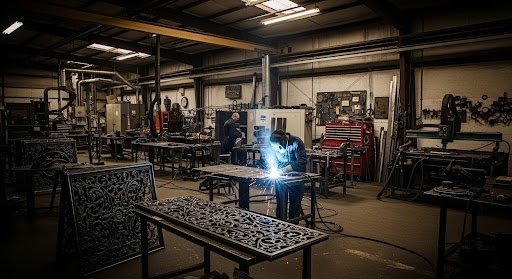Ontario workshops have been seeking ways to remain competitive without increasing their expenses for many years. As manufacturing grows more aggressive, small and medium-sized shops recognize that traditional methods of cutting are not doing the trick. This is where laser cutting comes in. From production speed to reduced material waste, laser cutting is allowing workshops throughout the province to improve their bottom line and remain competitive with customer demands.
Table of Contents
Why Laser Cutting is Becoming Popular
Efficiency is one of the basic reasons why laser cutting is being applied to Ontario workshops. Traditional processes such as sawing or mechanical shearing are labor-intensive and take time. Laser cutting, however, uses a concentrated beam of light to produce precise, clean cuts. Laser cutting can cut through steel, aluminum, stainless steel, and a host of other materials, making it useful for a lot of industries.
Speed is another benefit. A job that would take hours with hand cutting can often be completed in minutes with a laser cutter. For shops that are under the pressure of delivering on time, this is enormous. Customers can tolerate faster turnaround, and laser cutting enables shops to deliver it without sacrificing quality.
Saving Money with Less Waste
Waste reduction is likely the most obvious way workshops can cut costs on the bottom line. Traditional cutting tends to create a lot of scrap material because it is less accurate. Laser cutting creates nice, precise cuts, and thus more of the sheet is utilized and less scrap is discarded. With time, this waste saving equates to substantial savings.
For instance, in the cutting of intricate patterns, mechanical tools cannot be precise true, and components must be rejected. Laser cutters sidestep this issue by tracing programmed lines with almost flawless precision. That precision is translated directly into cost savings since material waste is less and fewer components are retried.
Meeting Modern Design Needs
Ontario industry is shifting towards more intricate designs and specialized jobs. For auto parts, construction panels, or electronics, clients demand accuracy and consistency. Laser cutting is tailor-made to meet that need. The technology permits workshops to deal with intricately detailed patterns which would be nigh on impossible to do with traditional equipment.
Another benefit is flexibility. If a customer needs the design altered, the shop does not have to create a new physical model. The shop can alter the digital design file and create the new version on the machine. This reduces downtime and enables shops to perform more custom work without extra cost.
Cutting Labor Costs
Labor will be the largest cost for any shop. Hand cutting involves more effort from the hands, from setup to completion. Laser cutting eliminates that need. The operators insert the material, load the job, and let the machine do all of it. Although skilled workers must be available to monitor the procedure, the number of procedures and hours is immensely less.
This does not involve replacing workers. Rather, they will be able to spend their time on more meaningful tasks like design, assembly, or inspection. This way, workshops maximize the use of their workers’ skills and eliminate unnecessary labor costs.
Also read this: The Rise of Laser Welding
Maintaining Competitiveness in Ontario’s Market
Ontario workshops are not only competing within provinces but also from all over Canada and abroad. In order to remain competitive, they must provide good products at an affordable price. Laser cutting is becoming a useful tool in this competition.
By investing in this technology, workshops demonstrate to customers that they can stay up-to-date with today’s standards. It can even provide new opportunities. A shop that only used to undertake basic parts, for instance, can now quote more complicated patterns or tighter tolerances. That versatility creates new business and keeps existing clients happy.
Energy Efficiency and Sustainability
Increased numbers of Ontario companies are placing importance on sustainability and energy consumption. Although laser cutting machines operate on electricity, they are more energy-efficient than mechanical devices that need to exert continuous physical force. Since laser cutting reduces waste material to a minimum, it is also an environmentally conscious practice.
Customers are more aware of sustainability in choosing suppliers. A shop that practices low-waste, efficient cutting techniques has an advantage in securing contracts from firms that appreciate cleaner production.
Automation and Software Integration
One more reason why laser cutting is the better option is that it can be imbedded with contemporary computer software. Designs are made in CAD programs and then inputted directly into the cutting system. The use of computer design and physical fabrication decreases mistakes and simplifies the manufacturing process.
see this: Roof Repair Mooresville
Certain Ontario stores are even trying out automation in conjunction with laser cutting. Loading and unloading of sheets, for instance, can be done by material handling systems and so machines can operate for extended periods without requiring constant supervision. This technology reduces downtime and optimizes production, which is an easy measure of profitability.
Looking Ahead
The use of laser cutting in Ontario is bound to increase even more. With falling machine costs and advancing technology, small workshops can now easily afford it. That implies that even small firms with thin budgets will be able to enjoy the advantages of greater efficiency, less waste, and higher product quality. In Kitchener, where manufacturing is a key part of the local economy, laser cutting Kitchener services are becoming a go-to option for shops that want to keep up with demand and maintain precision.
For the time being, the course is charted. Ontario shops that have adopted laser cutting are not merely living in the moment. They are discovering actual, tangible means of enhancing their bottom lines while providing the quality and velocity that their customers demand.


